Food Operations Management: A Turkish Restaurant in Vancouver, Canada
VerifiedAdded on 2023/05/27
|7
|1811
|88
Essay
AI Summary
This essay explores the feasibility and operational aspects of establishing a Turkish ethnic restaurant in downtown Vancouver, Canada. It highlights the increasing demand for themed restaurants and ethnic cuisines, emphasizing the exotic nature of Turkish food and the potential for creating a culturally rich dining experience. The essay suggests West Broadway as a prime location due to its proximity to the Turkish Canadian Society and high foot traffic. It further details how various elements of food operations, including menu selection, live food counters, traditional décor, Turkish music, and staff attire, can reflect Turkish ethnicity and enhance the overall dining experience. The conclusion emphasizes the potential for success based on Vancouver's diverse culinary landscape and the unique appeal of Turkish culture, suggesting that a well-executed Turkish-themed restaurant can thrive in the city.
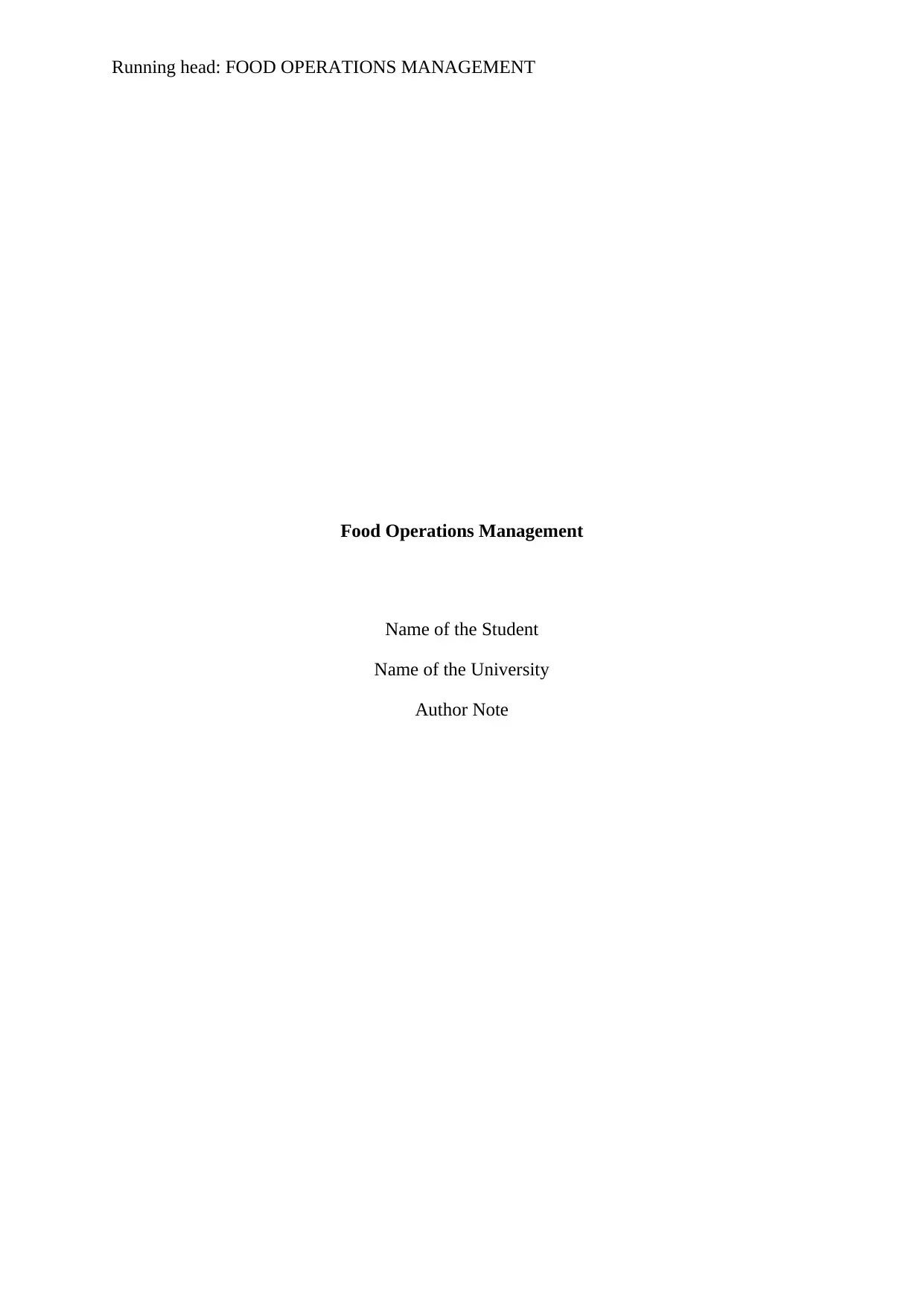
Running head: FOOD OPERATIONS MANAGEMENT
Food Operations Management
Name of the Student
Name of the University
Author Note
Food Operations Management
Name of the Student
Name of the University
Author Note
Paraphrase This Document
Need a fresh take? Get an instant paraphrase of this document with our AI Paraphraser
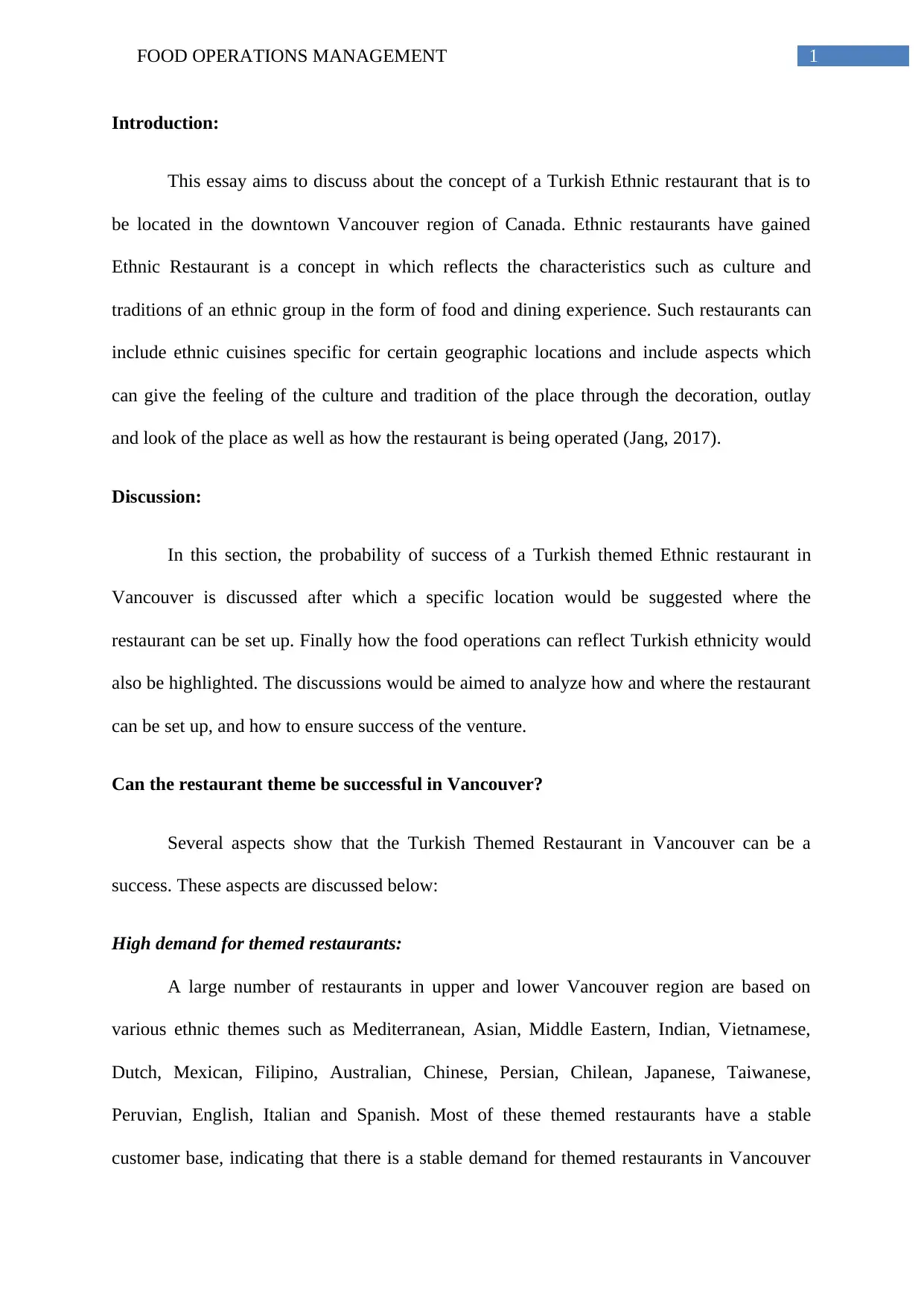
1FOOD OPERATIONS MANAGEMENT
Introduction:
This essay aims to discuss about the concept of a Turkish Ethnic restaurant that is to
be located in the downtown Vancouver region of Canada. Ethnic restaurants have gained
Ethnic Restaurant is a concept in which reflects the characteristics such as culture and
traditions of an ethnic group in the form of food and dining experience. Such restaurants can
include ethnic cuisines specific for certain geographic locations and include aspects which
can give the feeling of the culture and tradition of the place through the decoration, outlay
and look of the place as well as how the restaurant is being operated (Jang, 2017).
Discussion:
In this section, the probability of success of a Turkish themed Ethnic restaurant in
Vancouver is discussed after which a specific location would be suggested where the
restaurant can be set up. Finally how the food operations can reflect Turkish ethnicity would
also be highlighted. The discussions would be aimed to analyze how and where the restaurant
can be set up, and how to ensure success of the venture.
Can the restaurant theme be successful in Vancouver?
Several aspects show that the Turkish Themed Restaurant in Vancouver can be a
success. These aspects are discussed below:
High demand for themed restaurants:
A large number of restaurants in upper and lower Vancouver region are based on
various ethnic themes such as Mediterranean, Asian, Middle Eastern, Indian, Vietnamese,
Dutch, Mexican, Filipino, Australian, Chinese, Persian, Chilean, Japanese, Taiwanese,
Peruvian, English, Italian and Spanish. Most of these themed restaurants have a stable
customer base, indicating that there is a stable demand for themed restaurants in Vancouver
Introduction:
This essay aims to discuss about the concept of a Turkish Ethnic restaurant that is to
be located in the downtown Vancouver region of Canada. Ethnic restaurants have gained
Ethnic Restaurant is a concept in which reflects the characteristics such as culture and
traditions of an ethnic group in the form of food and dining experience. Such restaurants can
include ethnic cuisines specific for certain geographic locations and include aspects which
can give the feeling of the culture and tradition of the place through the decoration, outlay
and look of the place as well as how the restaurant is being operated (Jang, 2017).
Discussion:
In this section, the probability of success of a Turkish themed Ethnic restaurant in
Vancouver is discussed after which a specific location would be suggested where the
restaurant can be set up. Finally how the food operations can reflect Turkish ethnicity would
also be highlighted. The discussions would be aimed to analyze how and where the restaurant
can be set up, and how to ensure success of the venture.
Can the restaurant theme be successful in Vancouver?
Several aspects show that the Turkish Themed Restaurant in Vancouver can be a
success. These aspects are discussed below:
High demand for themed restaurants:
A large number of restaurants in upper and lower Vancouver region are based on
various ethnic themes such as Mediterranean, Asian, Middle Eastern, Indian, Vietnamese,
Dutch, Mexican, Filipino, Australian, Chinese, Persian, Chilean, Japanese, Taiwanese,
Peruvian, English, Italian and Spanish. Most of these themed restaurants have a stable
customer base, indicating that there is a stable demand for themed restaurants in Vancouver
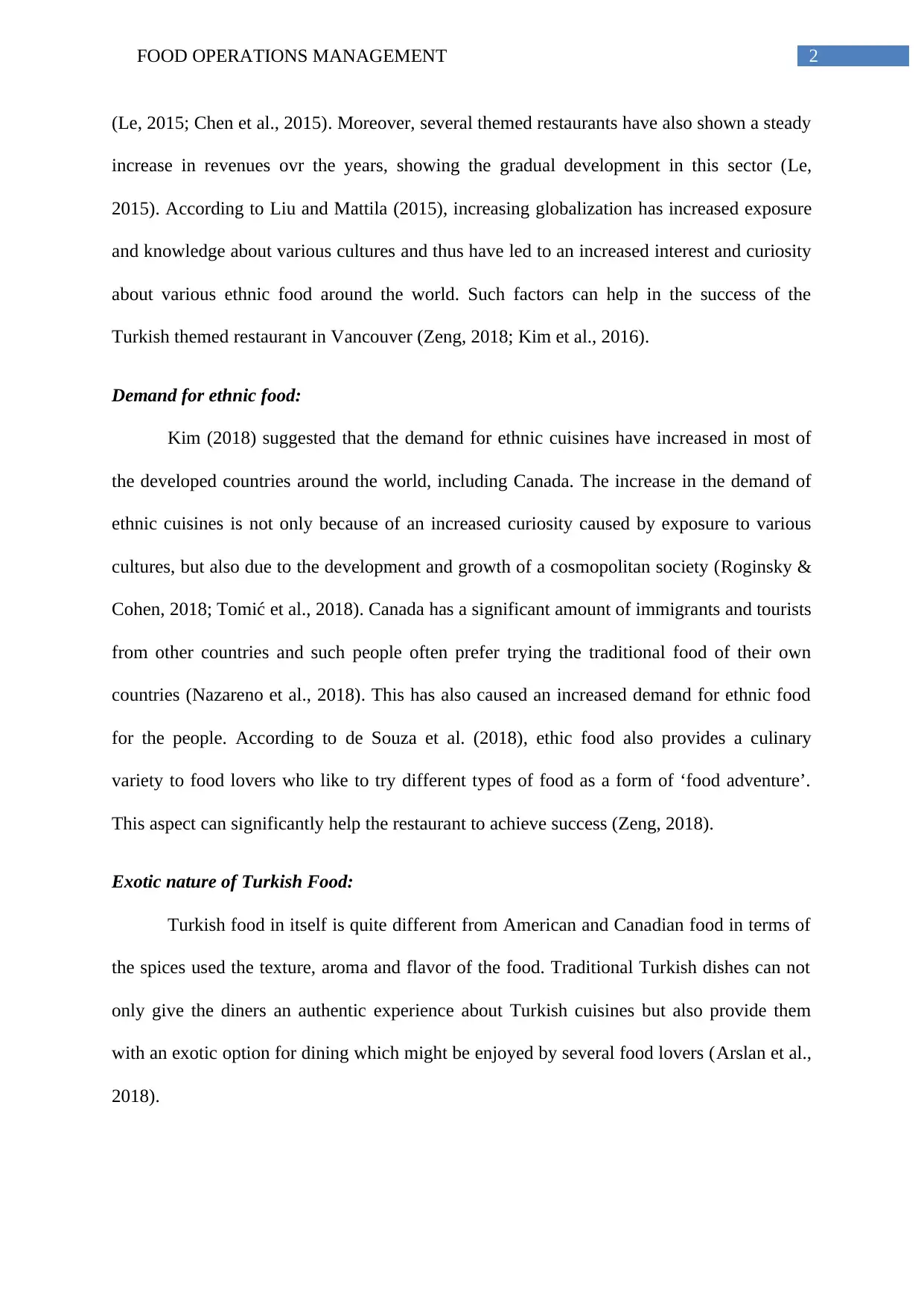
2FOOD OPERATIONS MANAGEMENT
(Le, 2015; Chen et al., 2015). Moreover, several themed restaurants have also shown a steady
increase in revenues ovr the years, showing the gradual development in this sector (Le,
2015). According to Liu and Mattila (2015), increasing globalization has increased exposure
and knowledge about various cultures and thus have led to an increased interest and curiosity
about various ethnic food around the world. Such factors can help in the success of the
Turkish themed restaurant in Vancouver (Zeng, 2018; Kim et al., 2016).
Demand for ethnic food:
Kim (2018) suggested that the demand for ethnic cuisines have increased in most of
the developed countries around the world, including Canada. The increase in the demand of
ethnic cuisines is not only because of an increased curiosity caused by exposure to various
cultures, but also due to the development and growth of a cosmopolitan society (Roginsky &
Cohen, 2018; Tomić et al., 2018). Canada has a significant amount of immigrants and tourists
from other countries and such people often prefer trying the traditional food of their own
countries (Nazareno et al., 2018). This has also caused an increased demand for ethnic food
for the people. According to de Souza et al. (2018), ethic food also provides a culinary
variety to food lovers who like to try different types of food as a form of ‘food adventure’.
This aspect can significantly help the restaurant to achieve success (Zeng, 2018).
Exotic nature of Turkish Food:
Turkish food in itself is quite different from American and Canadian food in terms of
the spices used the texture, aroma and flavor of the food. Traditional Turkish dishes can not
only give the diners an authentic experience about Turkish cuisines but also provide them
with an exotic option for dining which might be enjoyed by several food lovers (Arslan et al.,
2018).
(Le, 2015; Chen et al., 2015). Moreover, several themed restaurants have also shown a steady
increase in revenues ovr the years, showing the gradual development in this sector (Le,
2015). According to Liu and Mattila (2015), increasing globalization has increased exposure
and knowledge about various cultures and thus have led to an increased interest and curiosity
about various ethnic food around the world. Such factors can help in the success of the
Turkish themed restaurant in Vancouver (Zeng, 2018; Kim et al., 2016).
Demand for ethnic food:
Kim (2018) suggested that the demand for ethnic cuisines have increased in most of
the developed countries around the world, including Canada. The increase in the demand of
ethnic cuisines is not only because of an increased curiosity caused by exposure to various
cultures, but also due to the development and growth of a cosmopolitan society (Roginsky &
Cohen, 2018; Tomić et al., 2018). Canada has a significant amount of immigrants and tourists
from other countries and such people often prefer trying the traditional food of their own
countries (Nazareno et al., 2018). This has also caused an increased demand for ethnic food
for the people. According to de Souza et al. (2018), ethic food also provides a culinary
variety to food lovers who like to try different types of food as a form of ‘food adventure’.
This aspect can significantly help the restaurant to achieve success (Zeng, 2018).
Exotic nature of Turkish Food:
Turkish food in itself is quite different from American and Canadian food in terms of
the spices used the texture, aroma and flavor of the food. Traditional Turkish dishes can not
only give the diners an authentic experience about Turkish cuisines but also provide them
with an exotic option for dining which might be enjoyed by several food lovers (Arslan et al.,
2018).
⊘ This is a preview!⊘
Do you want full access?
Subscribe today to unlock all pages.

Trusted by 1+ million students worldwide
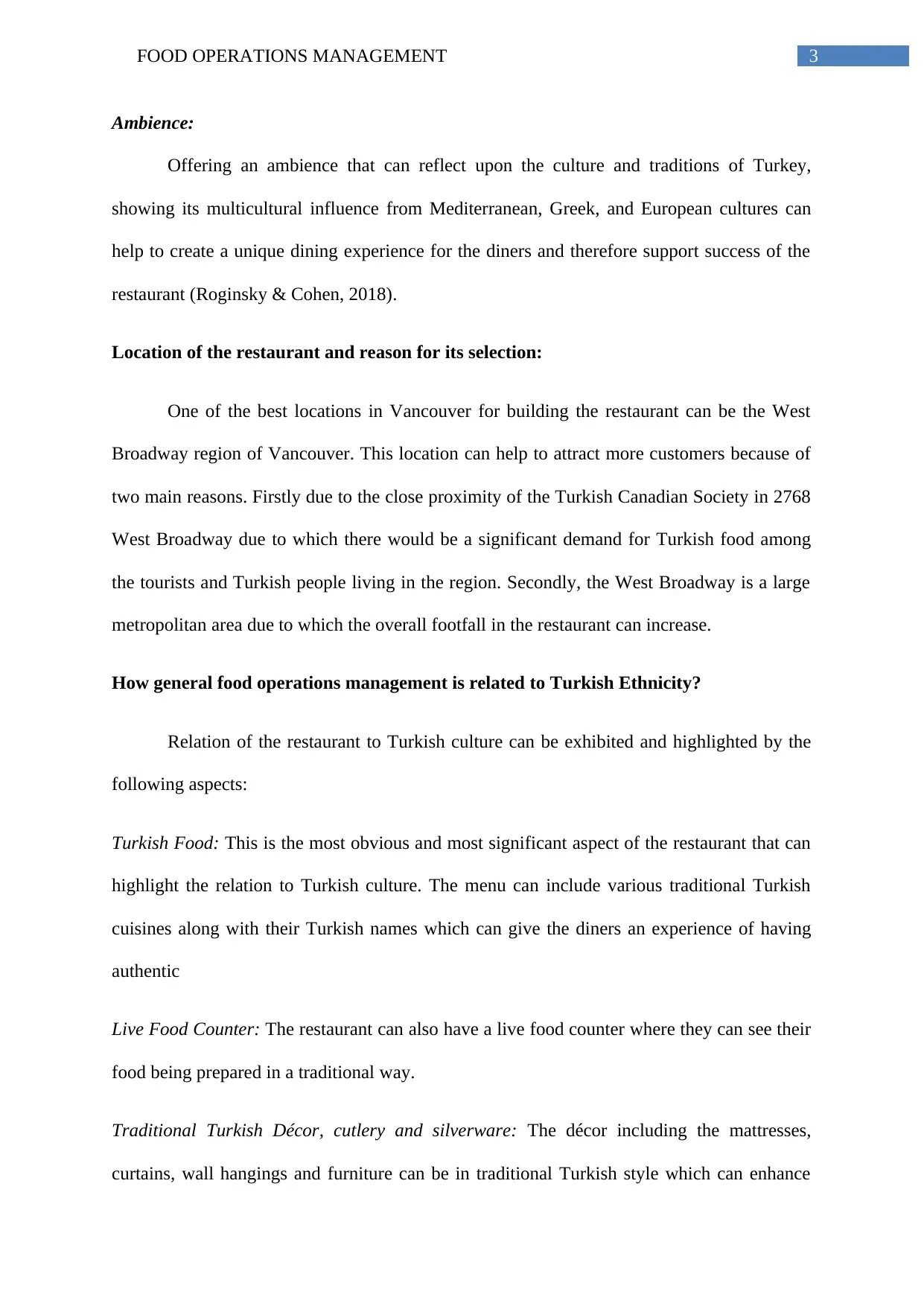
3FOOD OPERATIONS MANAGEMENT
Ambience:
Offering an ambience that can reflect upon the culture and traditions of Turkey,
showing its multicultural influence from Mediterranean, Greek, and European cultures can
help to create a unique dining experience for the diners and therefore support success of the
restaurant (Roginsky & Cohen, 2018).
Location of the restaurant and reason for its selection:
One of the best locations in Vancouver for building the restaurant can be the West
Broadway region of Vancouver. This location can help to attract more customers because of
two main reasons. Firstly due to the close proximity of the Turkish Canadian Society in 2768
West Broadway due to which there would be a significant demand for Turkish food among
the tourists and Turkish people living in the region. Secondly, the West Broadway is a large
metropolitan area due to which the overall footfall in the restaurant can increase.
How general food operations management is related to Turkish Ethnicity?
Relation of the restaurant to Turkish culture can be exhibited and highlighted by the
following aspects:
Turkish Food: This is the most obvious and most significant aspect of the restaurant that can
highlight the relation to Turkish culture. The menu can include various traditional Turkish
cuisines along with their Turkish names which can give the diners an experience of having
authentic
Live Food Counter: The restaurant can also have a live food counter where they can see their
food being prepared in a traditional way.
Traditional Turkish Décor, cutlery and silverware: The décor including the mattresses,
curtains, wall hangings and furniture can be in traditional Turkish style which can enhance
Ambience:
Offering an ambience that can reflect upon the culture and traditions of Turkey,
showing its multicultural influence from Mediterranean, Greek, and European cultures can
help to create a unique dining experience for the diners and therefore support success of the
restaurant (Roginsky & Cohen, 2018).
Location of the restaurant and reason for its selection:
One of the best locations in Vancouver for building the restaurant can be the West
Broadway region of Vancouver. This location can help to attract more customers because of
two main reasons. Firstly due to the close proximity of the Turkish Canadian Society in 2768
West Broadway due to which there would be a significant demand for Turkish food among
the tourists and Turkish people living in the region. Secondly, the West Broadway is a large
metropolitan area due to which the overall footfall in the restaurant can increase.
How general food operations management is related to Turkish Ethnicity?
Relation of the restaurant to Turkish culture can be exhibited and highlighted by the
following aspects:
Turkish Food: This is the most obvious and most significant aspect of the restaurant that can
highlight the relation to Turkish culture. The menu can include various traditional Turkish
cuisines along with their Turkish names which can give the diners an experience of having
authentic
Live Food Counter: The restaurant can also have a live food counter where they can see their
food being prepared in a traditional way.
Traditional Turkish Décor, cutlery and silverware: The décor including the mattresses,
curtains, wall hangings and furniture can be in traditional Turkish style which can enhance
Paraphrase This Document
Need a fresh take? Get an instant paraphrase of this document with our AI Paraphraser
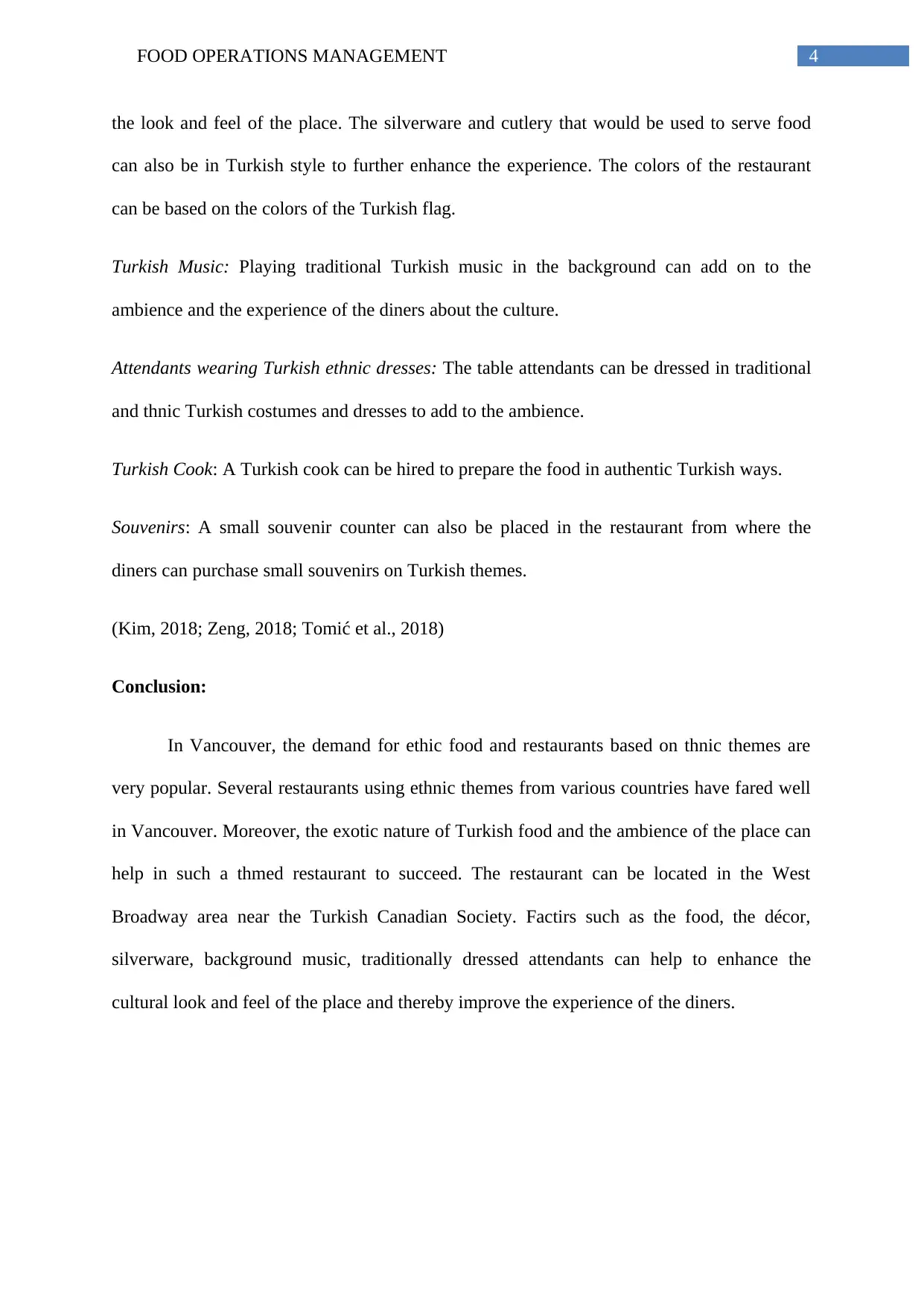
4FOOD OPERATIONS MANAGEMENT
the look and feel of the place. The silverware and cutlery that would be used to serve food
can also be in Turkish style to further enhance the experience. The colors of the restaurant
can be based on the colors of the Turkish flag.
Turkish Music: Playing traditional Turkish music in the background can add on to the
ambience and the experience of the diners about the culture.
Attendants wearing Turkish ethnic dresses: The table attendants can be dressed in traditional
and thnic Turkish costumes and dresses to add to the ambience.
Turkish Cook: A Turkish cook can be hired to prepare the food in authentic Turkish ways.
Souvenirs: A small souvenir counter can also be placed in the restaurant from where the
diners can purchase small souvenirs on Turkish themes.
(Kim, 2018; Zeng, 2018; Tomić et al., 2018)
Conclusion:
In Vancouver, the demand for ethic food and restaurants based on thnic themes are
very popular. Several restaurants using ethnic themes from various countries have fared well
in Vancouver. Moreover, the exotic nature of Turkish food and the ambience of the place can
help in such a thmed restaurant to succeed. The restaurant can be located in the West
Broadway area near the Turkish Canadian Society. Factirs such as the food, the décor,
silverware, background music, traditionally dressed attendants can help to enhance the
cultural look and feel of the place and thereby improve the experience of the diners.
the look and feel of the place. The silverware and cutlery that would be used to serve food
can also be in Turkish style to further enhance the experience. The colors of the restaurant
can be based on the colors of the Turkish flag.
Turkish Music: Playing traditional Turkish music in the background can add on to the
ambience and the experience of the diners about the culture.
Attendants wearing Turkish ethnic dresses: The table attendants can be dressed in traditional
and thnic Turkish costumes and dresses to add to the ambience.
Turkish Cook: A Turkish cook can be hired to prepare the food in authentic Turkish ways.
Souvenirs: A small souvenir counter can also be placed in the restaurant from where the
diners can purchase small souvenirs on Turkish themes.
(Kim, 2018; Zeng, 2018; Tomić et al., 2018)
Conclusion:
In Vancouver, the demand for ethic food and restaurants based on thnic themes are
very popular. Several restaurants using ethnic themes from various countries have fared well
in Vancouver. Moreover, the exotic nature of Turkish food and the ambience of the place can
help in such a thmed restaurant to succeed. The restaurant can be located in the West
Broadway area near the Turkish Canadian Society. Factirs such as the food, the décor,
silverware, background music, traditionally dressed attendants can help to enhance the
cultural look and feel of the place and thereby improve the experience of the diners.
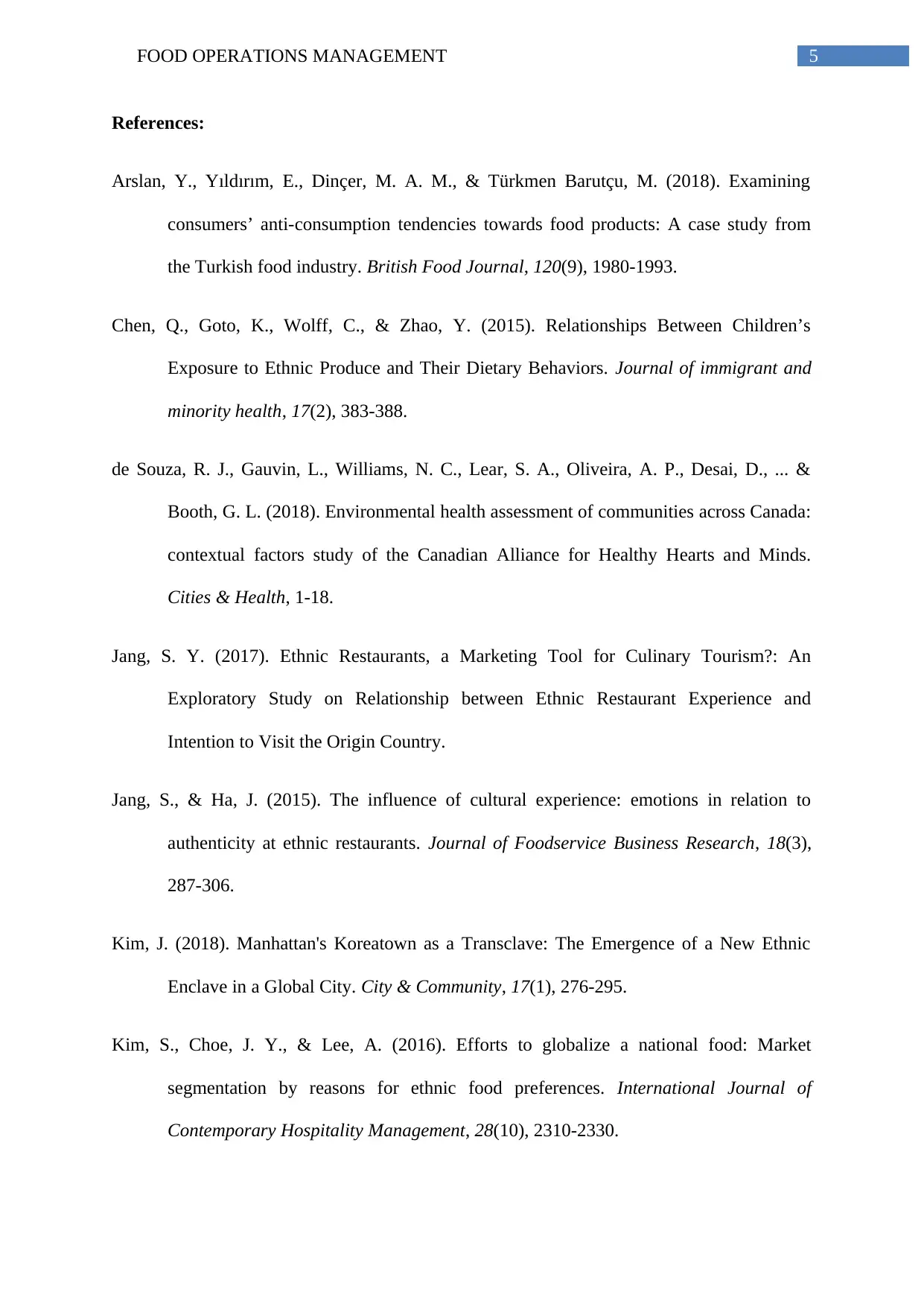
5FOOD OPERATIONS MANAGEMENT
References:
Arslan, Y., Yıldırım, E., Dinçer, M. A. M., & Türkmen Barutçu, M. (2018). Examining
consumers’ anti-consumption tendencies towards food products: A case study from
the Turkish food industry. British Food Journal, 120(9), 1980-1993.
Chen, Q., Goto, K., Wolff, C., & Zhao, Y. (2015). Relationships Between Children’s
Exposure to Ethnic Produce and Their Dietary Behaviors. Journal of immigrant and
minority health, 17(2), 383-388.
de Souza, R. J., Gauvin, L., Williams, N. C., Lear, S. A., Oliveira, A. P., Desai, D., ... &
Booth, G. L. (2018). Environmental health assessment of communities across Canada:
contextual factors study of the Canadian Alliance for Healthy Hearts and Minds.
Cities & Health, 1-18.
Jang, S. Y. (2017). Ethnic Restaurants, a Marketing Tool for Culinary Tourism?: An
Exploratory Study on Relationship between Ethnic Restaurant Experience and
Intention to Visit the Origin Country.
Jang, S., & Ha, J. (2015). The influence of cultural experience: emotions in relation to
authenticity at ethnic restaurants. Journal of Foodservice Business Research, 18(3),
287-306.
Kim, J. (2018). Manhattan's Koreatown as a Transclave: The Emergence of a New Ethnic
Enclave in a Global City. City & Community, 17(1), 276-295.
Kim, S., Choe, J. Y., & Lee, A. (2016). Efforts to globalize a national food: Market
segmentation by reasons for ethnic food preferences. International Journal of
Contemporary Hospitality Management, 28(10), 2310-2330.
References:
Arslan, Y., Yıldırım, E., Dinçer, M. A. M., & Türkmen Barutçu, M. (2018). Examining
consumers’ anti-consumption tendencies towards food products: A case study from
the Turkish food industry. British Food Journal, 120(9), 1980-1993.
Chen, Q., Goto, K., Wolff, C., & Zhao, Y. (2015). Relationships Between Children’s
Exposure to Ethnic Produce and Their Dietary Behaviors. Journal of immigrant and
minority health, 17(2), 383-388.
de Souza, R. J., Gauvin, L., Williams, N. C., Lear, S. A., Oliveira, A. P., Desai, D., ... &
Booth, G. L. (2018). Environmental health assessment of communities across Canada:
contextual factors study of the Canadian Alliance for Healthy Hearts and Minds.
Cities & Health, 1-18.
Jang, S. Y. (2017). Ethnic Restaurants, a Marketing Tool for Culinary Tourism?: An
Exploratory Study on Relationship between Ethnic Restaurant Experience and
Intention to Visit the Origin Country.
Jang, S., & Ha, J. (2015). The influence of cultural experience: emotions in relation to
authenticity at ethnic restaurants. Journal of Foodservice Business Research, 18(3),
287-306.
Kim, J. (2018). Manhattan's Koreatown as a Transclave: The Emergence of a New Ethnic
Enclave in a Global City. City & Community, 17(1), 276-295.
Kim, S., Choe, J. Y., & Lee, A. (2016). Efforts to globalize a national food: Market
segmentation by reasons for ethnic food preferences. International Journal of
Contemporary Hospitality Management, 28(10), 2310-2330.
⊘ This is a preview!⊘
Do you want full access?
Subscribe today to unlock all pages.

Trusted by 1+ million students worldwide
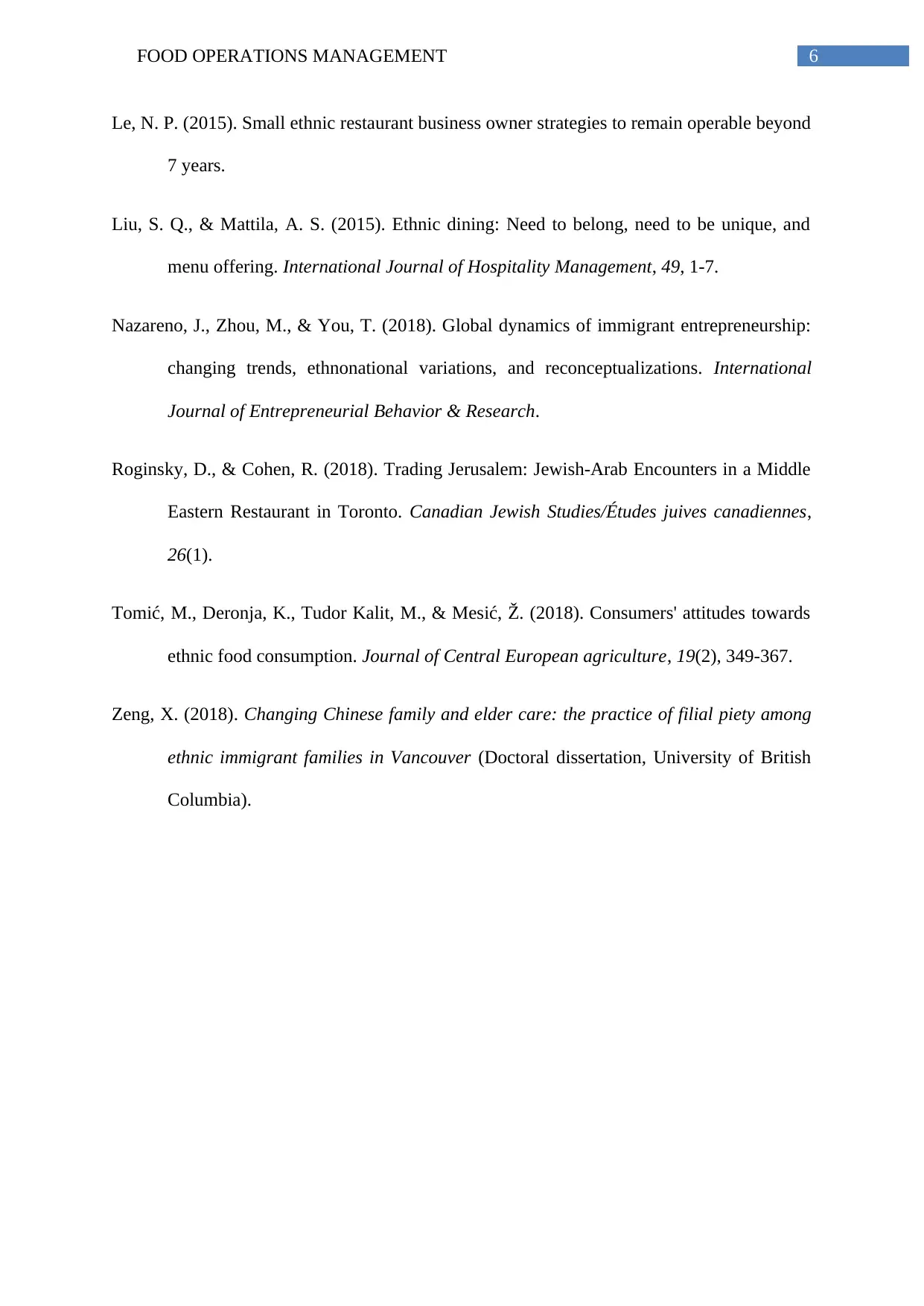
6FOOD OPERATIONS MANAGEMENT
Le, N. P. (2015). Small ethnic restaurant business owner strategies to remain operable beyond
7 years.
Liu, S. Q., & Mattila, A. S. (2015). Ethnic dining: Need to belong, need to be unique, and
menu offering. International Journal of Hospitality Management, 49, 1-7.
Nazareno, J., Zhou, M., & You, T. (2018). Global dynamics of immigrant entrepreneurship:
changing trends, ethnonational variations, and reconceptualizations. International
Journal of Entrepreneurial Behavior & Research.
Roginsky, D., & Cohen, R. (2018). Trading Jerusalem: Jewish-Arab Encounters in a Middle
Eastern Restaurant in Toronto. Canadian Jewish Studies/Études juives canadiennes,
26(1).
Tomić, M., Deronja, K., Tudor Kalit, M., & Mesić, Ž. (2018). Consumers' attitudes towards
ethnic food consumption. Journal of Central European agriculture, 19(2), 349-367.
Zeng, X. (2018). Changing Chinese family and elder care: the practice of filial piety among
ethnic immigrant families in Vancouver (Doctoral dissertation, University of British
Columbia).
Le, N. P. (2015). Small ethnic restaurant business owner strategies to remain operable beyond
7 years.
Liu, S. Q., & Mattila, A. S. (2015). Ethnic dining: Need to belong, need to be unique, and
menu offering. International Journal of Hospitality Management, 49, 1-7.
Nazareno, J., Zhou, M., & You, T. (2018). Global dynamics of immigrant entrepreneurship:
changing trends, ethnonational variations, and reconceptualizations. International
Journal of Entrepreneurial Behavior & Research.
Roginsky, D., & Cohen, R. (2018). Trading Jerusalem: Jewish-Arab Encounters in a Middle
Eastern Restaurant in Toronto. Canadian Jewish Studies/Études juives canadiennes,
26(1).
Tomić, M., Deronja, K., Tudor Kalit, M., & Mesić, Ž. (2018). Consumers' attitudes towards
ethnic food consumption. Journal of Central European agriculture, 19(2), 349-367.
Zeng, X. (2018). Changing Chinese family and elder care: the practice of filial piety among
ethnic immigrant families in Vancouver (Doctoral dissertation, University of British
Columbia).
1 out of 7
Related Documents
Your All-in-One AI-Powered Toolkit for Academic Success.
+13062052269
info@desklib.com
Available 24*7 on WhatsApp / Email
![[object Object]](/_next/static/media/star-bottom.7253800d.svg)
Unlock your academic potential
Copyright © 2020–2025 A2Z Services. All Rights Reserved. Developed and managed by ZUCOL.



